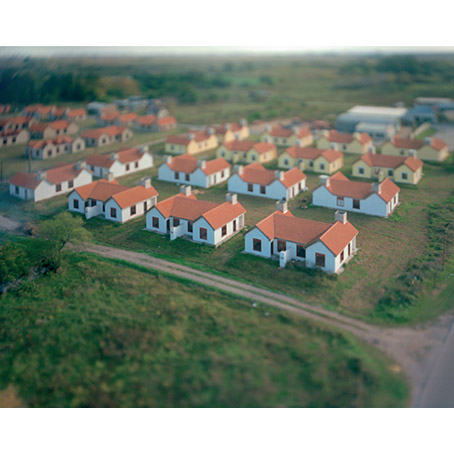10 YEARS OF LEICAWORLD, Photography International, Hans- Michael Koetzle, 02/2006
Houston Fotofest
AH YES, REALITY
Houston seems a long way off, but the trip is worth the effort. It is not the famous stars who are celebrated here. It is the emerging artists who are presented at the Fotofest. Every kind of visual strategy is pursued, without adhering to one single restrictive concept. A link to the problems of this world, however, is not unwelcome.
ONE WOULD NOT BE FAR wrong in associating the name of Houston, Texas, with high-tech, cattle and folklore, even if this is not the entire story. Houston also stands for art and culture, mainly on account of a wealthy upper class with an interest in art. Aficionados of surrealistic art are well acquainted with the Menil Collection, which has probably the world's largest number of Magritte paintings. Those interested in photographs have heard of the Museum of Fine Arts, which quite recently acquired the superb Manfred Heiting Collection (cf. p. 9). The problem is that Houston is not necessarily on the roadmap of international art tourism, a fact that had also to be taken into consideration when it came to establishing a photo festival in America's fourth biggest city. Fred Baldwin and Wendy Watriss, both prominent photojournalists, now retired, had to come up with something special if they intended to attract attention and tempt a public with an interest in photography into coming to Houston. Their concept was as follows: we do not show what is shown in New York, for example. And we give young photographers a genuine chance to make a name for themselves.
'Start-up' is the word that springs to mind. And with their 'Meeting Place', that is, the portfolio reviews that are held here, the initiators in fact set a genuine standard that meanwhile has its imitators from Arles to Birmingham.
Houston is the festival for discovering mostly young or contemporary photographers, a fact also true of this thirteenth edition of the biennial - again supported by Leica Camera. Once again the slightly more than forty exhibitions had been subsumed under one or rather two topics that only at first glance had nothing to do with each other: the environment ('The Earth'), and art and violence ('Artists Responding to Violence'). There were also various sideshows, for example, the Discovery Show showing the finds of the last festival. One of these is the young Argentinean photographer, Esteban Pastorino Díaz. Díaz is an example of the new generation of photographers who are no longer concerned simply with well seen, beautiful pictures, but - against the background of a changed media world - with questions of seeing and the perception of reality. From a technical point of view, his large-format photographs are aerial pictures taken from heights of 15 to 120 metres and acquire a distinctly surreal touch owing to the angle of vision and a deliberately selected partial sharpness of focus. One might speak of a 'Gulliver' effect that not only makes big things appear small, in other words miniaturises our world in an amazing way, but also compels us to look anew at familiar objects by suddenly bringing them irritatingly into focus and leaving the rest of the picture blurred. A young British Leica photographer who has already made a name for herself in the world of photography is Heidi Bradner, who presented herself at a well arranged exhibition with an essay about the Nenets, a nomadic people in northern Siberia. Looking at the pictures one might be reminded of Ragnar Axelsson or Claudine Doury, and this impression is not so wrong. Their reports are also dedicated to a life under extreme conditions, in snow and ice. And there is something else this new generation of young documentary photographers has in common: their commitment to the Leica system, which never fails to work even at extremely low temperatures: "I used my Leica in storms", says Heidi Bradner, "because it just kept working even though I had snowdrifts on my camera." What distinguishes Bradner's essay is the closeness, spiritual and real, to a people that has completely submitted its life's rhythm to nature. In quiet, well constructed pictures, Bradner tells of a frugal life far away from what we usually refer to as civilisation, proving not least that, even in the era of the jet and the Internet there exists - in the best sense of the word - 'something foreign' that is worth exploring with conventional means.
Andrew Z. Glickman is the name of our discovery at the portfolio reviews. The young American presented himself, strictly speaking, with a topic that is not exactly brand new. Walker Evans had already photographed people using public transport. Luc Delahaye did the same a while ago. 'Leica World' readers will also remember the portfolios of Tom Wood and Luis Mallo. What distinguishes Glickman is that he does not come as a stranger or an artist or a photographer. He comes as a participant, not looking for the exceptional but the normal. Glickman, who lives in Washington, uses the subway every day to go to his office. Like Wood he has also made a virtue of necessity and turns the ride underground into a photographic challenge. Equipped with the discreet Leica M he seeks, not the bizarre, not the event, but the 'study', as Roland Barthes has it; in other words that cool naturalness which - pictured so plainly and clearly - appears artificially staged. Thematically and stylistically Díaz, Bradner, Glickman may go different ways. What they stand for is a critical interest in our reality. And in a photographic art that does not derive its possibilities from the computer. hmk This year's Fotofest was held from March 10 to April 23. The 14th edition of the festival, which is supported by Leica Camera AG, is planned for the beginning of 2008. www.fotofest.org
